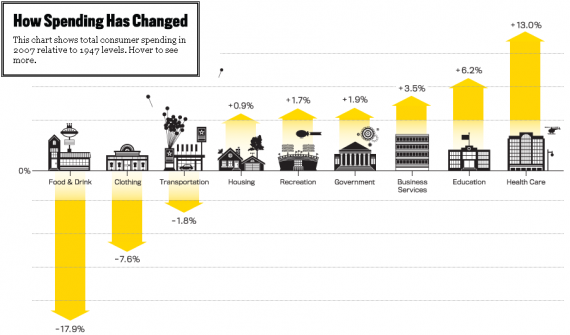America’s Spending Habits
At the apex of the last economic boom, we were spending far less as a percentage of our income on food, clothing, and transportation than our predecessors of half a century before, with the surplus going mostly to education and health care.
A piece by Stephen J. Rose in The Atlantic titled “How We Spend” includes this infographic:
The version at the site is interactive but the snapshot is interesting. At the apex of the last economic boom, we were spending far less as a percentage of our income on food, clothing, and transportation than our predecessors of half a century before, with the surplus going mostly to education and health care. That’s not particularly surprising. This, perhaps, is:
If we drill down further—to see not just the categories we spend on but where our dollars go within those categories—the picture is even more dramatic. Taking 1967 as our starting point, 30% of the cost of the things we consumed that year went to manufacturing them; by 2007, that figure had fallen to 16%. In contrast, what we spent on business services over the same period jumped from 12% to 26%. That’s because baked into the price of everything we buy is the rising cost of advertising, accounting, legal services, insurance, real estate, consulting, and the like—jobs performed by the high-wage workers of our modern economy. These days, 52% of all compensation goes to office workers. That includes the manufacturing sector: nearly a third of workers aren’t on the factory floor; they’re behind desks.
Interesting.







Nightmarish. The office politics, toadying, flourescent lights. The permanent attachment to a smartphone. People who never shut up. The meaningless work in service to Faceless Corporation X as employee # 118692-B.
What a lovely way to live.
The guy from FIAT that runs Chrysler now was on 60 Minutes a few weeks ago…and counter to right-wing propoganda he praised the Union Workers and their contributions to getting the company back on even ground…he said the biggest problem Chrysler had was in the office towers…deadweight and bulky hierarchies.
Actually, while the temptation is to think the “surplus” goes elsewhere, food is no doubt crowded out, especially in the recent term.
We know the quality of the American diet has fallen, and we probably are aware that price is part of the driver.
I mean, in these threads at OTB I’ve been told that healthy food is a luxury
(We often pride ourselves that we spend less as a percentage of income on food than, say, Italians, but we don’t always stop and ask if they are eating better.)
Not particularly surprising when you consider manufacturing now accounts for only 11% of GDP and six out of seven workers are employed in service industries or govt. And even within the process of providing actual products of all kinds (as distinct from services) there has been an enormous shift in power from production to distribution. As an aside it’s these realities that make comparisons between the US govt/economy and corporations (or even more ludicrously households) so misplaced.
@john personna:
Do we pride ourselves upon it? I can’t imagine the thought ever crosses most people’s minds anymore than the thought that we pride ourselves on spending less on clothing than Italians. For whatever cultural, social and economic reasons (which are very complicated) it’s a consumption choice.
@Brummagem Joe:
I’ve heard it, kind of a stages of wealth thing, that we are more “advanced” and so spend less money on food than other peoples.
As I say, it begs the question what happens to the food budget when the rent goes up.
@john personna:
Interestingly in the past couple of weeks I’ve eaten out in a traditional Italian American household (the main course was a variety of cheap offal) and in a very typical American home. One was awful and the other absolutely delicious. I’ll leave you to guess which.
So I was at a Chinese strip-mall take-out, and I ask the lady “what’s that one?” She turns to her co worker, and says something in Chinese, the other lady responds, they have a long conversation in Chinese, and then turn to me and say “pork.”
lol, it was intestine, but it was good.
@john personna:
Do we? I’d argue that the food we eat today is, on the whole, far better quality, more diverse, and more refined than it was 30 years ago.
@john personna: Yeah, it’s complicated. I don’t think it’s money that’s the primary driving issue but rather time. The combination of more single parent households and more dual-career households is that most of us don’t have the time to shop for fresh food and prepare meals in the way that was the case even when I was growing up. I tend to compensate for it with meats and vegetables that can be quickly prepared on a grill and with decent take-out food but the cheap, easy alternative is McDonalds.
@Stormy Dragon:
We is an awfully large generalisation. Certainly there is a much more diverse choice of foods than 30 years ago but I’m not sure that it is all of better quality and the consumption of processed foods of all sorts is also far higher than thirty years ago. And if you stretch the timeframe a bit more to say 50 years these differences are even more stark. Given our legendary obesity levels in this country something is wrong somewhere.
@john personna: I looked at a standard week’s diet when I was at my local Stop and Shop, and compared what I would have paid going through the standard aisles with what I paid from the organic section that I shopped at.
I literally paid 234% more.
Now, imagine if I compared that to the dollar menus at fast food places.
@Stormy Dragon:
You probably meant “refined” in the good sense, but flip it and you have the problem. The no-brainier way to respond to money and time pressure is with refined foods. They are not better for us.
As I’ve argued before, I think that people can eat pretty well, cheaply, and easily, but it takes some forethought.
Related:
@Christopher Bowen:
Dollar menus probably do pretty well on Calorie/$, but that’s about all you get.
Related:
Away-From-Home Foods Increasingly Important to Quality of American Diet
@Brummagem Joe:
The obesity problem really has little to do with the quality of our food and really has to do more with changes in lifestyle than what we’re eating.
But even here, my point stands. Even something like chicken mcnuggets, the ones McDonald’s is selling today are far higher quality chicken then the ones they sold back in the 80s. Likewise a week or so ago, I stopped at Wawa (a regional gas station/convenience store chain in Pennsylvania) to get an italian sandwhich for lunch and noticed they’re now selling lobster bisque. The idea that lobster bisque is something people would be looking to buy at a gas station convenience store would have seemed insane in the 80s.
@Stormy Dragon:
McNuggets? Seriously? First of all nuggets are only fractionally chicken. They are breaded and fried. But I’ll contest even the chicken part:
You should probably follow Mart Bittman on Twitter. You’ll come up to speed.
(And I don’t even want to know what is in service-station “lobster” bisque .. or what fraction was sourced in China.)
@john personna:
Then I’d suggest reading the label on any jar of honey you buy very carefully. We’re now importing chinese honey “blends” which are nothing of the sort. I wonder just how much of our food supply has been contaminated by the same people who were selling plastic rice.
@Ben Wolf: I buy local honey for about the same price 😛
@Stormy Dragon:
Actually it has rather a lot to do with nature of the food were eating.
graphic is quite meaningless, because there is no “we”…a minimum wage worker spend quite a larger percentage on food than jamie dimon…
@Stormy Dragon:
You wouldn’t actually like to produce some evidence of that would you?
@rjs:
Of course it’s meaningful. It’s measuring total US societal shifts not different consumption patterns between social classes as you seem to believe.
Here is an article about income by educational attainment. Note that no group is collectively earning what they did in 2000, but especially not those without a college degree.
So, given that education, housing, and medical care costs are rising, there is no “surplus,” and less is being spent on food (relative to 2000).
@Brummagem Joe: I knew there was a problem with Chicken McNuggets when my dog turned up his nose at them and refused to eat them. And he was NOT a picky eater.